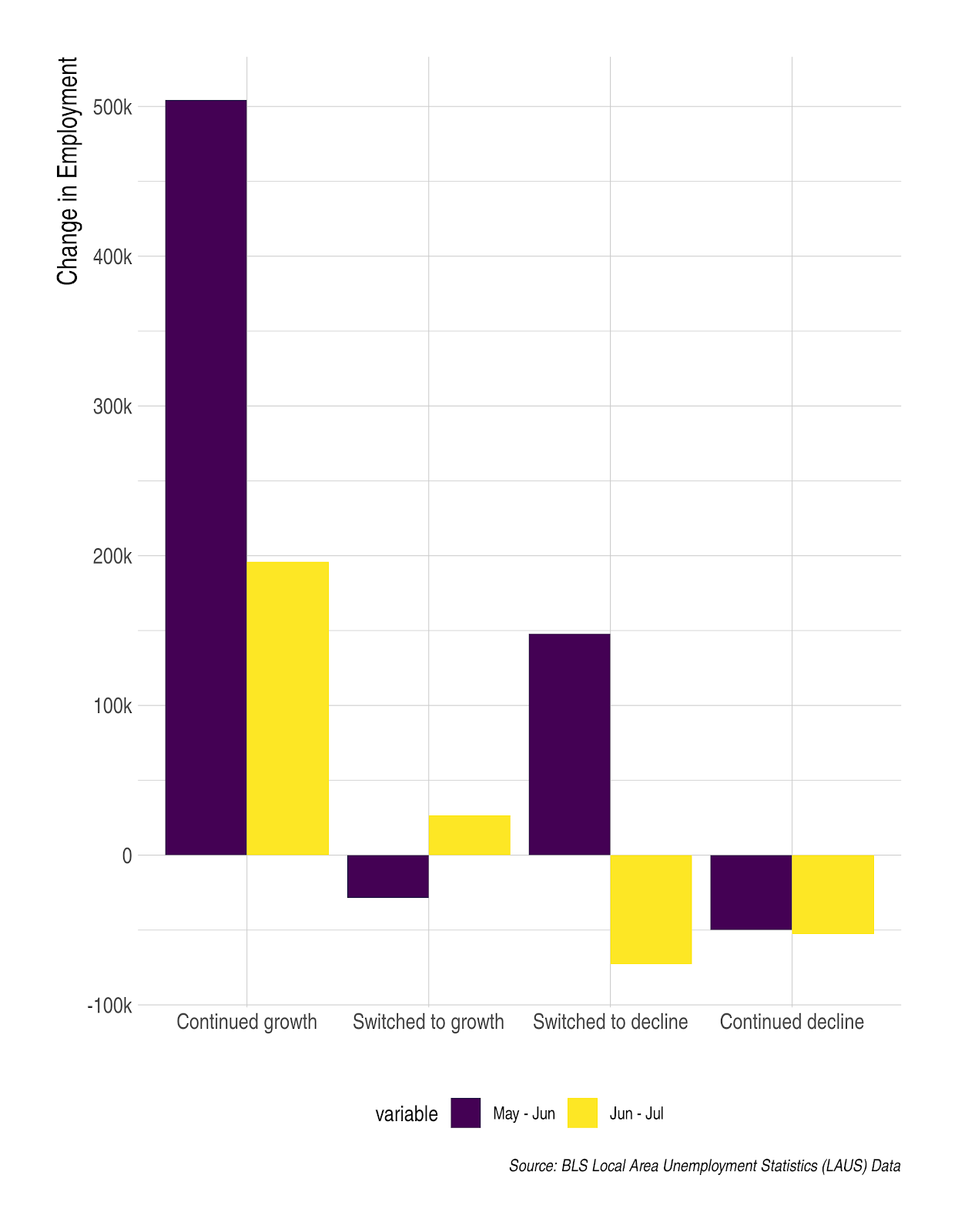CORI’s Employment Impact Update: July 2020
Each month in our Employment Impact Update, we share key findings, trends, detailed maps and analysis based on BLS monthly employment data to help you understand what’s happening to rural economies.
COVID-19 continues to have an unprecedented impact on the national economy. While the vast majority of pandemic-related coverage has focused on dense urban areas, smaller towns across the country have also felt deep health and economic shocks. Each month in our Employment Impact Update, we share key findings, trends, detailed maps and analysis based on BLS monthly employment data to help you understand what’s happening to rural economies.
Below are our key findings from the July data, released on September 4, 2020.
Topline numbers
Non-metro
- Non-metro areas gained 96,931 jobs from June to July, bringing the non-metro unemployment rate down to 8.7% from 8.2%. Overall, non-metro employment is still down 9.4% compared to February 2020.
Metro
- Metro areas gained 1.6 million jobs from June to July, bringing the metro unemployment down to 11.6% from 10.8%. Overall, employment in metro areas is still down 7.1% compared to February 2020.
Figure 1. Employment change (%) from February (pre-COVID) to July (current release).
A slowing recovery in rural America
County employment for July suggests that the economic recovery from the initial shocks of COVID-19 are slowing in rural America, far before returning to a pre-recession status quo.
- Overall, non-metro areas accounted for just 100,000 net new jobs from June to July, just 16% of the 600,000 net new jobs added in non-metro areas from May to June.
- The non-metro labor force decreased by 20,873 from June to July, reflecting a potentially troubling lack of workers in rural areas
- 477 non-metro counties that were growing in June lost employment in July, indicating that for some places, recovery remains uneven and far from guaranteed.
This overall slowdown in rural recovery has largely been driven by falling job creation among counties that had been on a strong growth trajectory. Among rural counties that recovered employment in both June and July, 500,000 new jobs were added in June, but less than 200,000 jobs were added in July.
While it is encouraging that these counties continue to add jobs instead of lose them, the sharp downward trend in growth raises concerns about a stagnating recovery. Additionally, rural recovery was slowed by 477 counties that added jobs in June but lost jobs in July, from a net positive of 150,000 to a net negative of 75,000.
One reason for this slowdown is likely the manufacturing sector. In July, manufacturers added just 26,000 jobs, less than 10% of the 365,000 jobs added by manufacturers in June. While manufacturing was less impacted than service sectors during the initial pandemic, the slowing recovery in manufacturing is concerning for the longer term recovery of rural areas. As of August, the manufacturing sector was still 674,000 jobs short of pre-pandemic levels.
A second factor contributing to a slowing recovery in rural America is the stagnation of hiring among small businesses which make up a disproportionate share of employment in rural areas. The share of small businesses that were increasing employee hours fell from 11% in June to 7% in August.
Moving forward, we’ll continue to monitor industry- and county-wide trends to identify the challenges and opportunities facing rural economies and inform our approach to empowering communities to lead sustainable recovery efforts.
Rural data matters
We’re in the midst of an economic crisis, and we aim to use these monthly datasets, in conjunction with our on-the-ground-knowledge and rural expertise, to help understand and predict what’s next for rural America — and equip leaders and policymakers with the tools to respond effectively. That’s why rural data like this is so important.
This data and our visualizations provide crucial insights into understanding what’s happening in rural America — insights that urban-focused or aggregated data often omit. If you’re a community leader looking to integrate this data to communicate with local stakeholders, see our tips for using data to tell your story.
Stay connected
And if you’re looking to respond to this economic crisis by pivoting to a more resilient digital economy, check out our toolkit for assessing your digital ecosystem, or contact us to learn how we can help.


